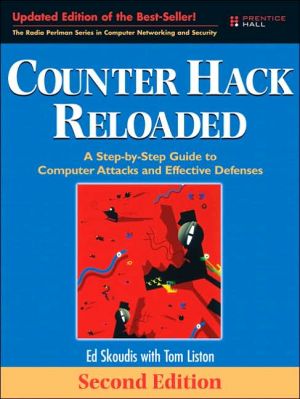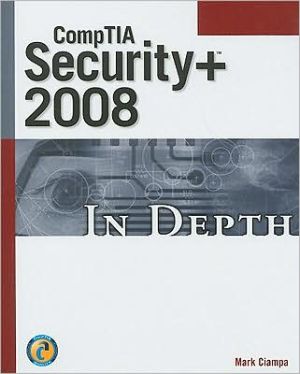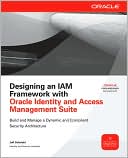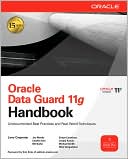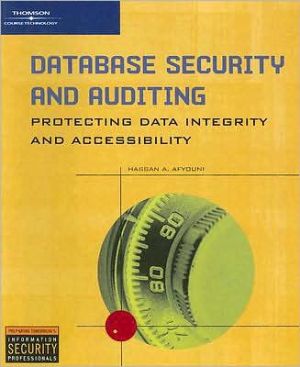Security in Computing
The New State-of-the-Art in Information Security: Now Covers the Economics of Cyber Security and the Intersection of Privacy and Information Security \ For years, IT and security professionals and students have turned to Security in Computing as the definitive guide to information about computer security attacks and countermeasures. In their new fourth edition, Charles P. Pfleeger and Shari Lawrence Pfleeger have thoroughly updated their classic guide to reflect today's newest technologies,...
Search in google:
The New State-of-the-Art in Information Security: Now Covers the Economics of Cyber Security and the Intersection of Privacy and Information SecurityFor years, IT and security professionals and students have turned to Security in Computing as the definitive guide to information about computer security attacks and countermeasures. In their new fourth edition, Charles P. Pfleeger and Shari Lawrence Pfleeger have thoroughly updated their classic guide to reflect today's newest technologies, standards, and trends.The authors first introduce the core concepts and vocabulary of computer security, including attacks and controls. Next, the authors systematically identify and assess threats now facing programs, operating systems, database systems, and networks. For each threat, they offer best-practice responses.Security in Computing, Fourth Edition, goes beyond technology, covering crucial management issues faced in protecting infrastructure and information. This edition contains an all-new chapter on the economics of cybersecurity, explaining ways to make a business case for security investments. Another new chapter addresses privacy—from data mining and identity theft, to RFID and e-voting.New coverage also includes Programming mistakes that compromise security: man-in-the-middle, timing, and privilege escalation attacks Web application threats and vulnerabilities Networks of compromised systems: bots, botnets, and drones Rootkits—including the notorious Sony XCP Wi-Fi network security challenges, standards, and techniques New malicious code attacks, including false interfaces and keystroke loggers Improving code quality: software engineering, testing, and liability approaches Biometric authentication: capabilities and limitations Using the Advanced Encryption System (AES) more effectively Balancing dissemination with piracy control in music and other digital content Countering new cryptanalytic attacks against RSA, DES, and SHA Responding to the emergence of organized attacker groups pursuing profit Booknews Covers all aspects of security in computing, including viruses, worms, Trojan horses, and other forms of malicious code; firewalls and the protection of networked systems; e-mail privacy, including PEM, PGP, key management, and certificates; key escrow--both as a technology and in the "Clipper" program; evaluation of trusted systems, including the Common Criteria, the ITSEC, and the OrangeBook; standards for program development and quality, including ISO9000; secure installations of PCs, UNIX, and networked environments; and ethical and legal issues in computing. Annotation c. Book News, Inc., Portland, OR (booknews.com)
Every day, the news media give more and more visibility to the effects of computer security on our daily lives. For example, on a single day in June 2006, the Washington Post included three important articles about security. On the front page, one article discussed the loss of a laptop computer containing personal data on 26.5 million veterans. A second article, on the front page of the business section, described Microsoft's new product suite to combat malicious code, spying, and unsecured vulnerabilities in its operating system. Further back, a third article reported on a major consumer electronics retailer that inadvertently installed software on its customers' computers, making them part of a web of compromised slave computers. The sad fact is that news like this appears almost every day, and has done so for a number of years. There is no end in sight.\ Even though the language of computer security—terms such as virus, Trojan horse, phishing, spyware—is common, the application of solutions to computer security problems is uncommon. Moreover, new attacks are clever applications of old problems. The pressure to get a new product or new release to market still in many cases overrides security requirements for careful study of potential vulnerabilities and countermeasures. Finally, many people are in denial, blissfully ignoring the serious harm that insecure computing can cause.\ Why Read This Book?\ Admit it. You know computing entails serious risks to the privacy and integrity of your data, or the operation of your computer. Risk is a fact of life: Crossing the street is risky, perhaps more so in some places than others, but you still cross the street. As a child you learned to stop and look both ways before crossing. As you became older you learned to gauge the speed of oncoming traffic and determine whether you had the time to cross. At some point you developed a sense of whether an oncoming car would slow down or yield. We hope you never had to practice this, but sometimes you have to decide whether darting into the street without looking is the best means of escaping danger. The point is all these matters depend on knowledge and experience. We want to help you develop the same knowledge and experience with respect to the risks of secure computing.\ How do you control the risk of computer security?\ \ Learn about the threats to computer security.\ Understand what causes these threats by studying how vulnerabilities arise in the development and use of computer systems.\ Survey the controls that can reduce or block these threats.\ Develop a computing style—as a user, developer, manager, consumer, and voter—that balances security and risk.\ \ The field of computer security changes rapidly, but the underlying problems remain largely unchanged. In this book you will find a progression that shows you how current complex attacks are often instances of more fundamental concepts.\ Users and Uses of This Book\ This book is intended for the study of computer security. Many of you want to study this topic: college and university students, computing professionals, managers, and users of all kinds of computer-based systems. All want to know the same thing: how to control the risk of computer security. But you may differ in how much information you need about particular topics: Some want a broad survey, while others want to focus on particular topics, such as networks or program development.\ This book should provide the breadth and depth that most readers want. The book is organized by general area of computing, so that readers with particular interests can find information easily. The chapters of this book progress in an orderly manner, from general security concerns to the particular needs of specialized applications, and finally to overarching management and legal issues. Thus, the book covers five key areas of interest:\ \ introduction: threats, vulnerabilities, and controls\ encryption: the "Swiss army knife" of security controls\ code: security in programs, including applications, operating systems, database management systems, and networks\ management: building and administering a computing installation, from one computer to thousands, and understanding the economics of cybersecurity\ law, privacy, ethics: non-technical approaches by which society controls computer security risks\ \ These areas are not equal in size; for example, more than half the book is devoted to code because so much of the risk is at least partly caused by program code that executes on computers.\ The first chapter introduces the concepts and basic vocabulary of computer security. Studying the second chapter provides an understanding of what encryption is and how it can be used or misused. Just as a driver's manual does not address how to design or build a car, Chapter 2 is not for designers of new encryption schemes, but rather for users of encryption. Chapters 3 through 7 cover successively larger pieces of software: individual programs, operating systems, complex applications like database management systems, and finally networks, which are distributed complex systems. Chapter 8 discusses managing and administering security, and describes how to find an acceptable balance between threats and controls. Chapter 9 addresses an important management issue by exploring the economics of cybersecurity: understanding and communicating the costs and benefits. In Chapter 10 we turn to the personal side of computer security as we consider how security, or its lack, affects personal privacy. Chapter 11 covers the way society at large addresses computer security, through its laws and ethical systems. Finally, Chapter 12 returns to cryptography, this time to look at the details of the encryption algorithms themselves.\ Within that organization, you can move about, picking and choosing topics of particular interest. Everyone should read Chapter 1 to build a vocabulary and a foundation. It is wise to read Chapter 2 because cryptography appears in so many different control techniques. Although there is a general progression from small programs to large and complex networks, you can in fact read Chapters 3 through 7 out of sequence or pick topics of greatest interest. Chapters 8 and 9 may be just right for the professional looking for non-technical controls to complement the technical ones of the earlier chapters. These chapters may also be important for the computer science student who wants to look beyond a narrow view of bytes and protocols. We recommend Chapters 10 and 11 for everyone, because those chapters deal with the human aspects of security: privacy, laws, and ethics. All computing is ultimately done to benefit humans, and so we present personal risks and approaches to computing. Chapter 12 is for people who want to understand some of the underlying mathematics and logic of cryptography.\ What background should you have to appreciate this book? The only assumption is an understanding of programming and computer systems. Someone who is an advanced undergraduate or graduate student in computer science certainly has that background, as does a professional designer or developer of computer systems. A user who wants to understand more about how programs work can learn from this book, too; we provide the necessary background on concepts of operating systems or networks, for example, before we address the related security concerns.\ This book can be used as a textbook in a one- or two-semester course in computer security. The book functions equally well as a reference for a computer professional or as a supplement to an intensive training course. And the index and extensive bibliography make it useful as a handbook to explain significant topics and point to key articles in the literature. The book has been used in classes throughout the world; instructors often design one-semester courses that focus on topics of particular interest to the students or that relate well to the rest of a curriculum.\ What Is New In This Book?\ This is the fourth edition of Security in Computing, first published in 1989. Since then, the specific threats, vulnerabilities, and controls have changed, even though many of the basic notions have remained the same.\ The two changes most obvious to people familiar with the previous editions are the additions of two new chapters, on the economics of cybersecurity and privacy. These two areas are receiving more attention both in the computer security community and in the rest of the user population.\ But this revision touched every existing chapter as well. The threats and vulnerabilities of computing systems have not stood still since the previous edition in 2003, and so we present new information on threats and controls of many types. Change include:\ \ the shift from individual hackers working for personal reasons to organized attacker groups working for financial gain\ programming flaws leading to security failures, highlighting man-in-the-middle, timing, and privilege escalation errors\ recent malicious code attacks, such as false interfaces and keystroke loggers\ approaches to code quality, including software engineering, testing, and liability approaches\ rootkits, including ones from unexpected sources\ web applications' threats and vulnerabilities\ privacy issues in data mining\ WiFi network security\ cryptanalytic attacks on popular algorithms, such as RSA, DES, and SHA, and recommendations for more secure use of these\ bots, botnets, and drones, making up networks of compromised systems\ update to the Advanced Encryption System (AES) with experience from its first several years of its use\ the divide between sound authentication approaches and users' actions\ biometric authentication capabilities and limitations\ the conflict between efficient production and use of digital content (e.g., music and videos) and control of piracy\ \ In addition to these major changes, there are numerous small corrective and clarifying ones, ranging from wording and notational changes for pedagogic reasons to replacement, deletion, rearrangement, and expansion of sections.
ForewordPreface to the Third EditionCh. 1Is There a Security Problem in Computing?1Ch. 2Elementary Cryptography35Ch. 3Program Security95Ch. 4Protection in General-Purpose Operating Systems179Ch. 5Designing Trusted Operating Systems229Ch. 6Database Security309Ch. 7Security in Networks363Ch. 8Administering Security491Ch. 9Legal, Privacy, and Ethical Issues in Computer Security553Ch. 10Cryptography Explained629Bibliography691Index727
\ BooknewsCovers all aspects of security in computing, including viruses, worms, Trojan horses, and other forms of malicious code; firewalls and the protection of networked systems; e-mail privacy, including PEM, PGP, key management, and certificates; key escrow--both as a technology and in the "Clipper" program; evaluation of trusted systems, including the Common Criteria, the ITSEC, and the OrangeBook; standards for program development and quality, including ISO9000; secure installations of PCs, UNIX, and networked environments; and ethical and legal issues in computing. Annotation c. Book News, Inc., Portland, OR booknews.com\ \


